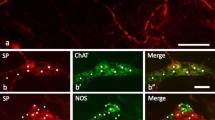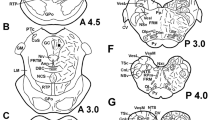Summary
The distribution of substance P (SP) immunofluorescence was investigated in the Gasserian ganglion, ophthalmic nerve and in the anterior segment of the rabbit eye. About one third of the nerve cell bodies in the Gasserian ganglion exhibited SP immunofluorescence, which was also observed in some nerve fibres of the ophthalmic nerve. In the cornea, some SP-positive iris contained numerous nerve fibres with SP immunofluorescence. In the sphincter area such fibres were circular, while the orientation of the SP fibres was radial in the dilator muscle. Both in the iris and in the ciliary body, the largest vessels were surrounded by nerves exhibiting SP immunofluorescence. A few nerve fibres also appeared in the stroma of the ciliary processes.
Similar content being viewed by others
References
Andres, K. H. (1961) Untersuchungen über den Feinbau von Spinalganglien.Z. Zellforsch. 55, 1–48.
Armstrong, D., Keele, C. A., Jepson, J. P. &Stewart, J. W. (1954) Development of pain-producing substance in human plasma.Nature New Biol. 174, 791–2.
Bill, A., Sijernschantz, J., Mandahl, A., Brodin, E. &Nilson, G. (1979) Substance P: Release on trigeminal nerve stimulation effects on the eye.Acta physiol. scand. 106, 371–3.
Butler, J. M., Powell, D. &Unger, W. G. (1980) Substance P levels in normal and sensorily denervated rabbit eyes.Exp. Eye Res. 30, 311–3.
Cuello, A. C., Jessell, T. M., Kanazava, I. &Iversen, L. L. (1977) Substance P: localization in synaptic vesicles in rat central nervous system.J. Neurochem. 29, 747–51.
Cuello, A. C., Calfre, G. &Milstein, C. (1979) Detection of substance P in the central nervous system by a monoclonal antibody.Proc. natn. Acad. Sci., U.S.A. 76, 3532–6.
Del Fiacco, M. &Cuello, A. C. (1980) Substance P- and enkephalin-containing neurones in the rat trigeminal system.Neuroscience 5, 803–15.
Hellauer, H. (1953) Charakterisierung der Erregungssubstanz sensibler Nerven.Naunyn-Schmiedebergs Arch. exp. Path. Pharmak. 219, 234–41.
Henry, J. L. (1977) Substance P and Pain: a possible relation in afferent transmission. InSubstance P (edited byEuler, U. S. v. andPernow, B.), pp. 231–240. New York: Raven Press.
Hökfelt, T., Kellerth, J.-O., Nilsson, G. &Pernow, B. (1975a) Morphological support for a transmitter role of substance P: immunohistochemical localization in the central nervous system and in primary sensory neurons.Science, N.Y. 190, 889–90.
Hökfelt, T., Kellerth, J.-O., Nilsson, G. &Pernow, B. (1975b) Experimental immunohistochemical studies on the localization and distribution of substance P in cat primary sensory neurons.Brain Res. 100, 235–52.
Hökfelt, T., Johansson, O., Kellerth, J.-O., Ljungdahl, A., Nilsson, G., Nygårds, A. &Pernow, B. (1977a) Immunohistochemical distribution of substance P. InSubstance P (edited byEuler, U. S. v. andPernow, B.), pp. 117–145. New York: Raven Press.
Hökfelt, T., Elfvin, L.-G., Schultzberg, M., Goldstein, M. &Nilsson, G. (1977b) On the occurrence of Substance P-containing fibres in sympathetic ganglia: immunohistochemical evidence.Brain Res. 132, 29–41.
Hoyes, A. D. &Barber, P. (1976) Ultrastructure of the corneal nerves in the rat.Cell Tiss. Res. 172, 133–44.
Jancsó, N. &Jancsó-Gabor, A. (1959) Dauerschaltung der chemischen Schmerzempfindlichkeit durch Capsaicin.Naunyn-Schmiedebergs Arch. exp. Path. Pharmak. 236, 142–5.
Jessell, T. M., Iversen, L. L. &Cuello, A. C. (1978) Capsaicin-induced depletion of substance P from primary sensory neurones.Brain Res. 152, 183–8.
Laties, A. &Jacobowitz, D. (1964) A histochemical study of the adrenergic and cholinergic innervation of the anterior segment of the rabbit eye.Invest. Ophthal. 3, 592–600.
Lembeck, F. (1953) Zur Frage der centralen übertragung afferenter Impulse. III. Das Vorkommen und die Bedeutung der Substanz P in den dorsalen Wurzeln des Rückenmarks.Arch. exp. Path. Pharmacol. 219, 197–213.
Lembeck, F., Gamse, R. &Juan, H. (1977) Substance P and sensory nerve endings. InSubstance P (edited byBuler, U. S. v. andPernow, B.), pp. 207–214. New York: Raven Press.
Fundberg, J. M., Hökfelt, T., Ånggård, A., Pernow, B. &Emson, P. (1979) Immunohistochemical evidence for substance P immunoreactive nerve fibres in the taste buds of the cat.Acta physiol. scand. 107, 389–91.
Matsuda, H. (1968) Electron microscopic study on the corneal nerves with special reference to the nerve endings.Acta soc. ophthalmol. jap. 72, 880–93.
Nilsson, G., Dahlberg, K., Brodin, E., Sundler, F. &Strandberg, K. (1977) Distribution and constrictor effect of substance P in guinea pig tracheobronchial tissue. InSubstance P (edited byEuler, U. S. v andPernow, B.), pp. 71–81. New York: Raven Press.
Otsuka, M. &Konishi, S. (1976) Release of substance P like immunoreactivity from isolated spinal cord of new born rat.Nature. Lond. 264, 83–4.
Pelletier, G., Leclerc, R. &Dupont, A. (1977) Electron microscopic immunohistochemical localization of substance P in the central nervous system of the rat.J. Histochem. Cytochem. 25, 1373–80.
Pickel, V. M., Reis, D. J. &Leeman, S. E. (1977) Ultrastructural localization of substance P in neurons of rat spinal cord.Brain Res. 122, 534–40.
Potter, G. D., Guzman, F. &Lim, R. K. S. (1962) Visceral pain evoked by intrarterial injection of substance P.Nature, Lond. 193, 938–84.
Randić, M. &Miletić, V. (1977) Effect of substance P in cat dorsal horn neurones activated by noxious stimuli.Brain Res. 128, 164–9.
Ruskell, G. L. (1974) Ocular fibres of the maxillary nerves in the monkey.J. Anat., Lond. 118, 195–203.
Schultzberg, M., Hökfelt, T., Nilsson, G., Terenius, L., Rehfeld, J. F., Brown, M., Elde, R., Goldstein, M. &Said, S. (1980) Distribution of peptide- and catecholamine-containing neurons in the gastro-intestinal tract of rat and guinea pig: immunohistochemical studies with antisera to substance P, vasoactive intestinal polypeptide, enkephalins, somatostatin, gastrin/cholecystokinin, neurotensin and dopamine-β-hydroxylase.Neuroscience 5, 689–744.
Sundler, F., Håkansson, R., Larsson, L.-I., Brodin, E. &Nilsson, G. (1977a) Substance P in the gut: an immunohistochemical study on its distribution and development. InSubstance P (edited byEuler, U. S. v. andPernow, B.), pp. 59–65. New York: Raven Press.
Sundler, F., Alumets, J., Brodin, E., Kahlberg, K. &Nilsson, G. (1977b) Disscussion: perivascular substance P-immunoreactive nerves in tracheo-bronchial tissue. InSubstance P (edited byEuler, U. S. v. andPernow, B.), pp. 271–273. New York: Raven Press.
Szolcsányi, J., Jancsó-Gabor, A. &Joo, F. (1975) Functional and fine structural characteristics on the sensory neuron blocking effect of capsaicin.Naunyn-Schmiedebergs Arch. exp. Path. Pharmak. 287, 157–69.
Takahashi, T. & Otsuka, M. (1974) Distribution of substance P in cat spinal cord and the alteration following unilateral dorsal root section.Jap. J. Pharmacol. 24, Suppl. 105.
Takahashi, T. &Otsuka, M. (1975) Regional distribution of substance P in the spinal cord and nerve roots of the cat and the effect of dorsal root section.Brain Res. 87, 1–11.
Tervo, T. (1976) Histochemical demonstration of cholinesterase activity in the cornea of the rat and the effects of various denervations on the corneal nerves.Histochemistry 47, 133–43.
Tefvo, T. (1978) Demonstration of adrenergic nerve fibres in the nasociliary but not in the opthalmic nerve of the rat.Exp. Eye Res. 27, 607–13.
Tefvo, T., Joo, F., Huikuri, K. T., Toth, I. &Palkama, A. (1979) Fine structure of sensory nerves in the rat cornea: an experimental nerve degeneration study.Pain 6, 57–70.
Umrath, K. (1953) Über die fermentative Verwandlung von Substanz P aus sensiblen Neuronen in die Erregungssubstanz der sensiblen Nerven.Pflügers Arch. ges. Physiol. 258, 230–42.
Zander, E. &Weddel, G. (1951) Reaction of corneal nerve fibres to injury.Br. J. Ophthalmol. 35, 61–97.
Author information
Authors and Affiliations
Rights and permissions
About this article
Cite this article
Tervo, K., Tervo, T., Eränkö, L. et al. Immunoreactivity for substance P in the gasserian ganglion, ophthalmic nerve and anterior segment of the rabbit eye. Histochem J 13, 435–443 (1981). https://doi.org/10.1007/BF01005059
Received:
Revised:
Issue Date:
DOI: https://doi.org/10.1007/BF01005059




